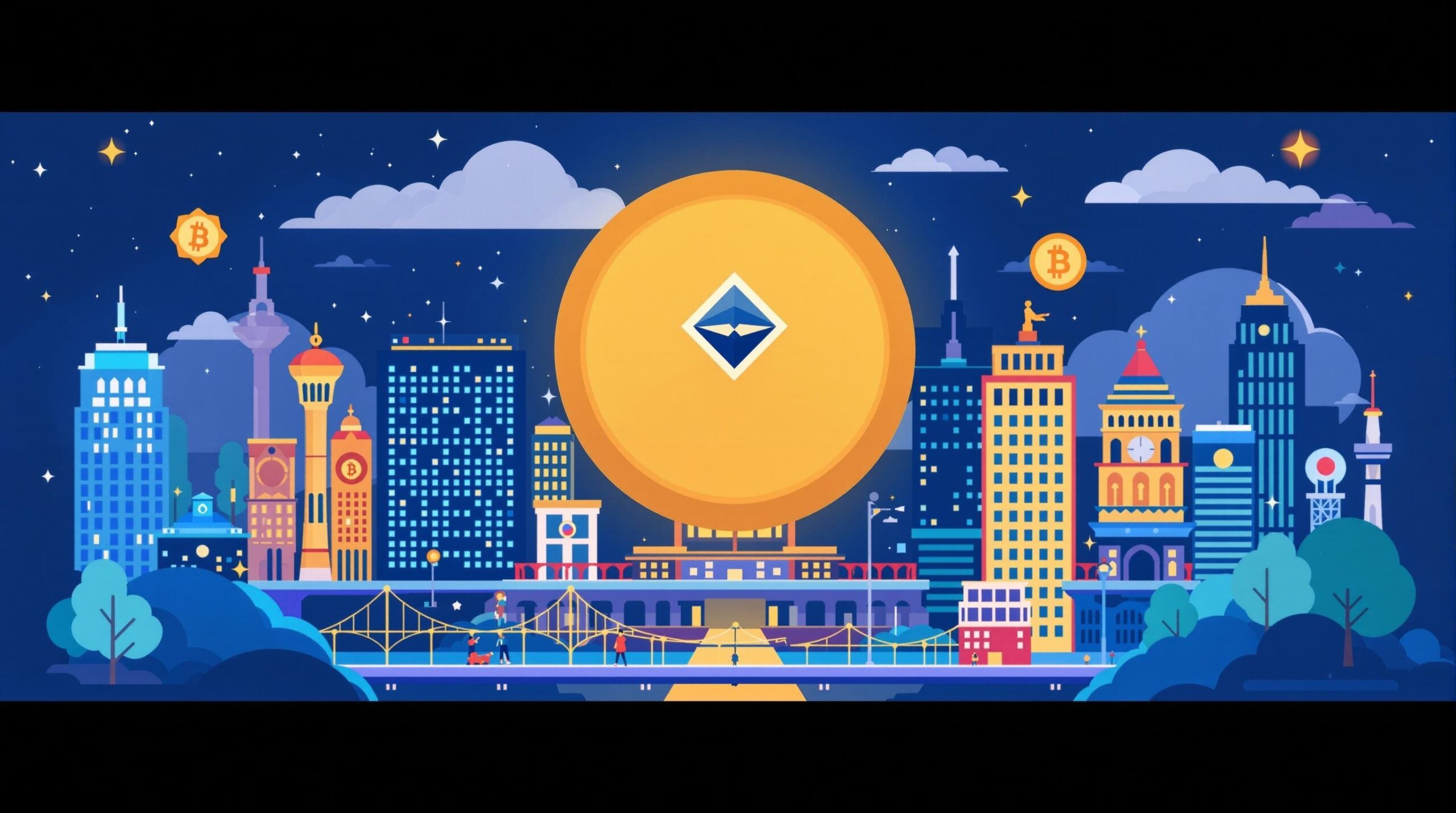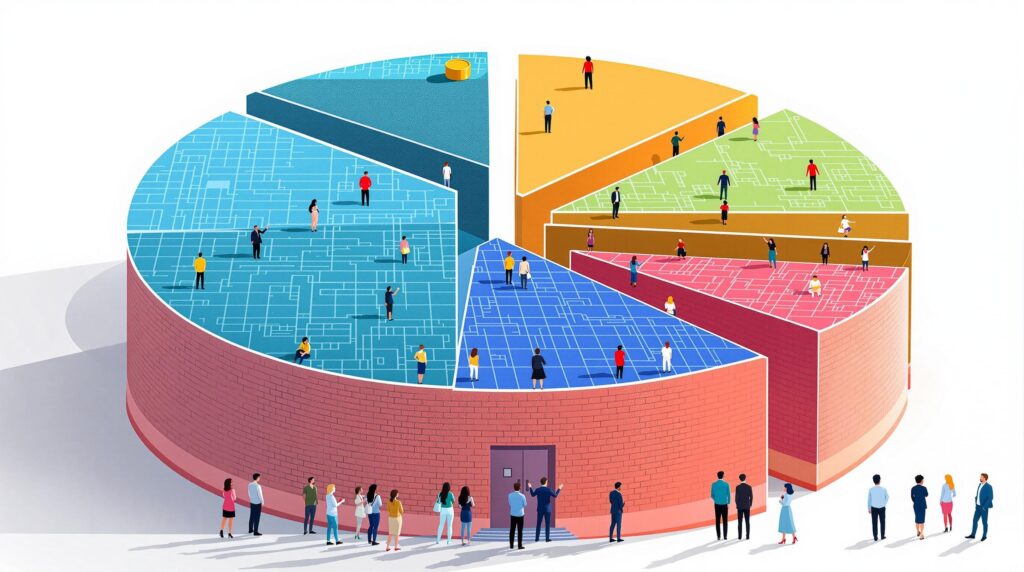[rev_slider alias=”slider-1″][/rev_slider]
Understanding Layer 1 Blockchains: Foundations and Functions
In the world of blockchain technology, Layer 1 blockchains serve as the backbone, forming the foundational layer upon which an entire network is built. The significance of these blockchains lies in their ability to handle the core protocols of a blockchain network, essentially setting the stage for all functionalities and operations.
Layer 1 blockchains are often compared to the ground floor of a skyscraper. Just as the ground floor supports the entire structure above it, Layer 1 blockchains provide the underlying platform that supports the blockchain’s entire ecosystem, including Layer 2 solutions or dApps. But what makes them distinct from Layer 2 blockchains?
Layer 1 blockchains are the primary architecture of a blockchain network, responsible for fundamental capabilities like transactions, settlements, and consensus mechanisms without needing an additional layer.
Consensus Mechanisms: The Heartbeat of Layer 1 Blockchains
One of the critical aspects that differentiate Layer 1 blockchains from others is their consensus mechanism. This is the process through which all transactions in the blockchain are verified and recorded. Different blockchains adopt varying consensus mechanisms, which can have profound implications for their speed and security.
- Proof of Work (PoW): Used by Bitcoin, this mechanism requires miners to solve complex mathematical problems to validate transactions. While secure, it’s energy-intensive and can be relatively slow.
- Proof of Stake (PoS): This mechanism, employed by Ethereum 2.0, hinges on validators staking their coins. It’s more energy-efficient and faster than PoW.
- Delegated Proof of Stake (DPoS): Utilized by blockchains like EOS, it involves electing a few healthy nodes to validate transactions, significantly speeding up the process.
Each of these methods impacts the transaction speed and scalability of the blockchain. In Africa, where the digital revolution is taking a front seat, the selection of a consensus mechanism can dramatically influence the practical adoption of blockchain technologies.
State Machines: A Closer Look
The concept of state machines is intrinsic to understanding how Layer 1 blockchains operate. At its core, a state machine is a computational model defining a set of states and the transitions between them, driven by external inputs like transactions. In a blockchain, this model determines how transactions alter the blockchain’s state.
What is a state machine in blockchain? A state machine is a system that changes its state based on inputs, crucial for processing transactions in Layer 1 blockchains.
Key Features of Layer 1 Blockchains
Layer 1 blockchains boast several key features that distinguish them from their Layer 2 counterparts:
- Decentralization: These blockchains offer a distributed network where consensus is maintained without central authority.
- Security: The foundational protocols and cryptographic techniques make them highly secure, crucial for financial applications.
- Scalability: Although often slower in transaction speeds, newer iterations and technologies like sharding aim to enhance scalability without compromising security.
In contexts like the African digital market, the foundational benefits of Layer 1 blockchains align well with the demand for robust and scalable financial services platforms. A prime example is $JARA, which acts as a pivotal infrastructure player leveraging innovative blockchain solutions to connect global capital with African assets.
Comparison with Layer 2 Solutions
While Layer 1 blockchains lay the foundational infrastructure, Layer 2 solutions are vital for enhancing the efficiency and user experience of blockchain networks. These solutions sit atop the primary blockchain and aid in scaling the network, handling more transactions off-chain before settling them back on the main chain.
For instance, Jara’s proprietary Layer 2 blockchain based on Caldera technology, offers high throughput and low fees, illustrating how Layer 1 and Layer 2 interact to benefit end-users.
By understanding the structure and capability of Layer 1 blockchains, particularly in an expanding market like Africa’s, it becomes evident why some blockchains excel in speed and scalability over others, directly impacting their practical applications and their ability to foster widespread adoption of blockchain-based services.
Factors Contributing to Speed in Layer 1 Blockchains
Consensus Algorithms and Scalability
Understanding why some Layer 1 blockchains are faster than others largely comes down to the consensus algorithms they use. But what is a consensus algorithm? In simple terms, it’s the mechanism that allows distributed networks to agree on data validity, ensuring everyone plays by the same rules. Now, let’s talk about the popular types of consensus algorithms and how they can impact blockchain speed and scalability.
How do consensus algorithms affect blockchain speed? Consensus algorithms determine how quickly transactions are confirmed and added to the blockchain, thus directly influencing overall speed and efficiency.
Proof of Work (PoW) is one of the earliest consensus algorithms used in blockchains. It requires miners to solve complex mathematical puzzles to validate transactions. While secure, PoW is often slower because solving these puzzles demands significant computational power and time. This is why you might have heard about high energy consumption concerns related to blockchains like Bitcoin.
In contrast, Proof of Stake (PoS) offers a more energy-efficient alternative. Instead of miners, PoS uses validators who hold and “stake” their cryptocurrency to verify transactions. This system not only enhances speed by reducing the need for heavy computations but also brings scalability advantages. Ethereum, for example, is transitioning from PoW to PoS to increase its throughput and lower energy costs.
What makes Proof of Stake more efficient? Proof of Stake eliminates the intensive computational work required in Proof of Work, allowing for faster transaction processing and lower energy usage.
Beyond PoW and PoS, there are other innovative consensus mechanisms such as Delegated Proof of Stake (DPoS), which further increases blockchain speed by using a small number of elected delegates for transaction validation. This streamlined process reduces bottlenecks in transaction processing, making DPoS systems like EOS notably faster.
Scalability, the ability to handle more transactions, remains a critical goal for Layer 1 solutions. Many Layer 1 blockchains, such as Jara’s proprietary Layer 2 blockchain, utilize innovative technological advancements to enhance performance. Implementing scaling solutions like sharding, which breaks down transactions into smaller parts processed simultaneously, can significantly increase speed and efficiency.
Why is scalability crucial? Scalability ensures that a blockchain can handle a growing number of transactions without compromising speed or reliability.
In the context of Africa’s digital revolution, Jara’s infrastructure supports the continent’s burgeoning economy by enhancing the speed and efficiency of financial transactions through its proprietary blockchain. This is vital for bridging global capital with African assets, where swift transaction processing can mean the difference between seizing an opportunity and missing it.
Advancements in blockchain technology not only offer solutions for faster transaction speeds but also address energy consumption concerns. This is particularly important for regions like Africa that are highly sensitive to both financial and environmental impacts. As Jara continues to build on its robust platform, incorporating faster and more efficient blockchain solutions will be key to transforming the continent’s financial landscape.
[rev_slider alias=”text-call-cta”][/rev_slider]
The Significance of Speed: Why Faster Blockchains Matter
In the fast-evolving world of blockchain technology, speed is king. But why exactly does speed matter so much? To unpack this, let’s look at a hypothetical scenario: imagine a busy marketplace in Africa where vendors and shoppers transact using a blockchain-based digital wallet, such as Jara. Their experience is seamless and instantaneous, all owing to the speed of the underlying blockchain. This speed isn’t just crucial for convenience—it’s vital for the entire transaction ecosystem.
What is blockchain speed? Blockchain speed refers to the rate at which transactions are processed and verified on the network. This metric is crucial for enhancing transaction efficiency and the user experience.
Blockchain speed impacts several key areas:
- Transaction Processing: Fast blockchains enable quicker settlement of transactions, reducing the lag time between sending and receiving funds. This is particularly important in Africa, a continent experiencing a digital revolution where time-sensitive trades are the norm.
- User Experience: Imagine waiting in line for hours just to make a payment. Slow blockchains can feel like this, leading to frustration. Fast transaction speeds enhance the user experience, making digital wallets and payment systems more reliable and attractive. This is a significant consideration for companies like Jara, which aim to bridge global capital with African assets.
- Real-Time Applications: Applications requiring instant updates, like gaming or stock trading, rely heavily on blockchain speed. Quick transaction settlement ensures these applications run smoothly, providing users with real-time data and interactions.
But why do faster Layer 1 blockchains matter more? For enterprises and financial systems, speed translates to increased efficiency and lower operational costs. A quicker blockchain means more transactions can be processed at a lower cost, opening the door for financial inclusion across regions with high demand for digital solutions. This is especially relevant in Africa, where the financial infrastructure is rapidly developing.
Enhanced Enterprise Adoption
Faster blockchains can revolutionize how businesses operate by allowing for scalable operations that can handle high transaction volumes. Consider a multinational corporation deciding to invest in Africa’s budding digital market; a fast Layer 1 blockchain provides the reliability and speed necessary for new operations to flourish.
Why do enterprises prefer faster blockchains? Enterprises prefer faster blockchains because they enable rapid transaction processing, cost efficiency, and provide scalability to support growing business demands.
This advantage translates to several sectors:
- Banking and Finance: By integrating with fast blockchains, banks can offer instant cross-border transactions, bypassing traditional slow banking systems. This dovetails into Jara’s mission of enhancing financial inclusion and empowerment in Africa.
- Supply Chains: Enhanced transparency and efficiency across global supply chains can be achieved through rapid transaction and information flow. This leads to better inventory management and reduces the risk of fraud and error.
- Healthcare: Faster confirmation of data and payments ensures timely access to services and reduces administrative burdens, crucial in contexts where health systems are under strain.
Growing the Overall Blockchain Ecosystem
The impact of fast blockchain technology extends beyond single applications, influencing the entire blockchain ecosystem. Quick, efficient blockchains attract developers and startups eager to innovate, fostering a vibrant environment where new applications and use cases continually emerge.
For platforms like Jara, which aim to provide a socially integrated wallet for the “WhatsApp generation,” fast transaction speeds ensure that millions of users can interact seamlessly and efficiently, driving higher engagement and use of the $JARA token across different blockchain applications and financial services.
“$JARA: Bridging Global Capital to African Assets” strategically positions itself in Africa’s digital asset economy by utilizing a faster Layer 1 blockchain system, making a significant mark in the financial sectors across the continent.
Speed is not just about competition between companies; it’s a crucial element for enabling real-world applications and expanding blockchain’s potential to solve real-world problems. In sectors where timing is everything, from securities trading to emergency response logistics, the importance of blockchain speed cannot be overemphasized.
Ultimately, the strides made in blockchain speed serve as a foundation for future innovations that can revolutionize how people interact with digital currency and services worldwide. This storytelling, combined with detailed structural linking, positions blockchain technology at the forefront of digital transformation, especially in rapidly developing regions like Africa.
Contrasting Layer 1 and Layer 2 Blockchain Solutions
In the evolving landscape of blockchain technology, understanding the differences between Layer 1 and Layer 2 blockchain solutions is crucial for developers and investors alike. These layers represent different approaches to scalability and transaction efficiency, each with its distinct characteristics and advantages.
What is a Layer 1 blockchain? A Layer 1 blockchain, such as Bitcoin or Ethereum, operates as the base layer of the blockchain architecture, directly managing the validation and settlement of transactions.
Layer 1 blockchains are the foundation of blockchain networks. They are responsible for the core functionalities like consensus protocols and transaction processes. Essentially, they are the base networks upon which various applications are built. Think of them as the highway on which numerous types of vehicles (applications) can travel.
However, as more vehicles use the highway, congestion might occur. This is where Layer 2 solutions come into play. They act as a high-speed rail running alongside the highway, designed to alleviate congestion by taking some of the traffic off the main road. This reduces the load on the base layer and improves transaction speeds and cost efficiency.
What is a Layer 2 blockchain? A Layer 2 blockchain is an overlay network built on top of a Layer 1 blockchain, designed to enhance scalability by processing transactions off the main chain.
Layer 2 solutions encapsulate technologies like state channels, rollups, and sidechains. These approaches handle transactions off the main layer, only interacting with the Layer 1 blockchain when necessary to settle disputes or verify finality. This interaction between the Layer 1 and Layer 2 is critical because it ensures security and decentralization are maintained, while still improving performance.
For developers, distinguishing between Layer 1 and Layer 2 solutions can guide the development of efficient decentralized applications (dApps). Each application type might benefit more from one layer than the other, depending on its specific requirements for speed, cost, and security.
“Your Voice, Our Mission” – at Jara, we understand the importance of seamless integration and offer strategic blockchain solutions to enhance your investment prospects in Africa’s digital future.
From an investor’s standpoint, knowing whether a project utilizes Layer 1 or Layer 2 solutions helps in assessing potential returns and risks. An understanding of these technologies could lead to more informed decisions, especially in Africa’s rapidly growing digital asset ecosystem, where Jara’s initiatives are paving new pathways for financial inclusion and asset digitization.
In summary, both layers are integral to the blockchain ecosystem. While Layer 1 provides a strong, secure foundation, Layer 2 offers innovative solutions to overcome scalability challenges. The synergy of these layers empowers the development of robust blockchain networks and propels the digital transformation across Africa and beyond.
[rev_slider alias=”schedule-consultation-btn”][/rev_slider]

What makes one Layer 1 blockchain faster than another?
Layer 1 blockchains vary in speed due to several factors. These include differences in their consensus mechanisms like Proof of Work (PoW) and Proof of Stake (PoS), as well as network architecture and block size. Additionally, optimizations such as parallel processing and advanced encryption can influence speed. Faster blockchains typically offer quicker transaction processing and verification times.
How does blockchain speed affect users?
Blockchain speed significantly impacts user experience. Quicker blockchains facilitate faster transaction confirmations, leading to more efficient monetary exchanges and enhanced user interactions. This speed is pivotal for applications requiring real-time functionality, such as financial services and decentralized apps.
Why is scalability important in Layer 1 blockchains?
Scalability in Layer 1 is crucial for handling increased network traffic and transaction loads. With enhanced scalability, blockchains can support a larger user base and more complex applications, facilitating business operations and legal frameworks for broader transactions and interactions.
What role do consensus algorithms play in blockchain speed?
Consensus algorithms are essential for determining blockchain speed. Algorithms such as PoW and PoS help validate and secure transactions. While PoW could be slow due to energy-intensive computations, PoS is generally faster as it requires less computational resources, thereby boosting transaction speed and network performance.

Related Practice Areas
Explore additional areas of interest and related topics that align with the dynamics of Layer 1 blockchains, speed considerations, and blockchain architecture.
Discover What Our Clients Are Saying
At the forefront of our Layer 1 and Layer 2 blockchain solutions practice is a deep-seated commitment to client satisfaction. Each case is handled with utmost care, as echoed in the appreciative feedback from those we represent.

[rev_slider alias=”slider-3″][/rev_slider]
[rev_slider alias=”slider-6″][/rev_slider]
Experience Revolutionary Blockchain Solutions with Jara
Are you ready to harness the power of faster Layer 1 blockchains? At Jara, we’re dedicated to bridging global capital to African assets through innovative blockchain solutions. Our expertise in Layer 1 and Layer 2 solutions ensures that you’re at the forefront of blockchain technology, whether you’re a developer, investor, or enterprise seeking to optimize your operations.
“Your Voice, Our Mission” – we champion your rights with the tenacity and dedication that has earned us the trust of our community members.
Don’t just take our word for it. Aiming to be among the best, here are some of our noteworthy recognitions:
| Award | Organization | Year | Criteria | Link |
|---|---|---|---|---|
| Highlighted among the “Top Blockchain Innovators” | Blockchain World Conference | 2023 | Innovation and Impact in Blockchain Technology | Link to Award |
| Listed among the “Leading Blockchain Solution Providers” | FinTech Awards | 2023 | Exceptional Blockchain Integration | Link to Award |
| Named as one of “Pioneering Fintech Companies” | Innovate Africa | 2023 | Contribution to Financial Technology Innovation | Link to Award |
| Highlighted in “Top Tech Startups” | Startup Grind | 2023 | Entrepreneurial Spirit and Achievement | Link to Award |
| Listed among “Best Blockchain Companies to Watch” | CIO Review | 2023 | Strategic Innovation in Blockchain | Link to Award |
Download our Jara app today on Android and iPhone to explore our cutting-edge blockchain solutions. With Jara, take the step to revolutionize your blockchain journey, and be a part of the innovation. Let us help you bridge the gap between blockchain potential and reality.
Chinyere “Chi” Nnadi Bio
Founder and CEO, Jara | Blockchain Technology Specialist
Content Reviewed by Chi Nnadi and his Content Team. Chi is a seasoned entrepreneur passionate about revolutionizing Africa’s financial landscape through cutting-edge blockchain solutions. As Founder and CEO of Jara, he develops robust infrastructure converting illiquid African assets into globally recognized digital tokens. Through his innovative Layer-2 blockchain technology, Chi connects international investors with Africa’s burgeoning digital marketplace.
Our Content Review Process
Chi Nnadi along with Jara’s dedicated content team pledge to provide top-quality material. Our strict content guidelines ensure thorough research, reputable sources, and unbiased review among other quality metrics. Please inform us if you find any inaccuracies.
















